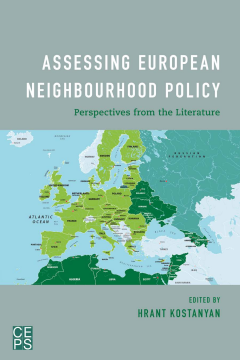
Additional Information
Book Details
Abstract
Several events in the past few years have dramatically shown how the interests of European citizens are directly affected by the stability, security and prosperity of their neighbouring regions. At the same time, the European Union and its member states face many challenges and dilemmas in designing and pursuing policies that not only effectively promote these interests, but also build stronger partnerships with neighbouring countries based on the values on which the Union is founded.
First the Arab revolts and then Russia’s assertiveness in the eastern neighbourhood prompted reviews by the EU of its European Neighbourhood Policy (ENP), in 2011 and 2015, respectively. These reviews, in turn, have renewed scholarly interest in the ENP. By deliberately focusing on the recent literature (since 2011), this book by CEPS identifies the factors that explain the (lack of) effectiveness and coherence of the ENP. This exercise has resulted in a rich overview of and deep reflection on a wide variety of ENP-related themes, such as conditionality and leverage, the interests vs values dilemma and the role of third parties. The study identifies where there is consensus among scholars and where perspectives and judgements differ. It also identifies important gaps in the literature where further research is needed.
This book will be of interest to a wide audience of officials, diplomats, parliamentarians, researchers at think tanks, civil society organisations, university teachers, trainers, students and journalists who want to know more about the challenges and dilemmas arising from the ENP.
The work has been carried out by a team of researchers from CEPS in Brussels, with the support of the Policy and Operations Evaluation Department (IOB) of the Ministry of Foreign Affairs of the Netherlands.
Dr. Hrant Kostanyan is a Researcher at CEPS, a Senior Key Expert at the College of Europe Natolin and an Adjunct Professor at Vesalius College. His research focuses on EU institutions and decision-making, primarily on the European External Action Service (EEAS), the European Neighbourhood Policy (ENP) and the EU’s relations with Eastern Neighbours and Russia.
Table of Contents
| Section Title | Page | Action | Price |
|---|---|---|---|
| Assessing European Neighbourhood Policy | Cover | ||
| CONTENTS | v | ||
| List of Abbreviations | vii | ||
| About the authors | ix | ||
| Foreword | xi | ||
| Summary | 1 | ||
| 1. Introduction | 7 | ||
| 1.1 Conceptualising and assessing the effectiveness and coherence of the ENP | 8 | ||
| 1.2 Work/research methods and plan | 12 | ||
| 1.3 Data collection strategy | 12 | ||
| 1.4 Structure | 14 | ||
| 2. Conditionality and Socialisation | 15 | ||
| 2.1 Positive conditionality: Membership prospects and visa liberalisation | 17 | ||
| 2.2 Negative conditionality | 21 | ||
| 2.3 Conditionality in the 2011 and 2015 ENP Reviews: More for more and differentiation | 26 | ||
| 2.4 Sectoral cooperation | 30 | ||
| 2.5 Institutionalisation of the ENP | 33 | ||
| 2.6 Conclusion | 35 | ||
| 3. Interests vs. Values | 39 | ||
| 3.1 The ambiguous nature of values | 39 | ||
| 3.2 Security/stability vs. democracy | 45 | ||
| 3.3 (Functional) cooperation with non-democratic regimes | 50 | ||
| 3.4 Conclusion | 54 | ||
| 4. Ownership and Local Dynamics | 57 | ||
| 4.1 Tailoring to local needs? | 58 | ||
| 4.2 Eastern neighbourhood | 61 | ||
| 4.3 Joint ownership | 63 | ||
| 4.4 Local ownership and civil society support | 65 | ||
| 4.5 Eurocentrism: A clash with local/regional values | 67 | ||
| 4.6 Conclusion | 70 | ||
| 5. Perception and Visibility | 73 | ||
| 5.1 Views from the EU | 73 | ||
| 5.2 Views from the neighbourhood | 79 | ||
| 5.3 Visibility and communication strategies | 88 | ||
| 5.4 Conclusion | 92 | ||
| 6. External Factors | 95 | ||
| 6.1 Southern neighbourhood | 96 | ||
| 6.1.1 The role of global actors | 99 | ||
| 6.1.2 Regional actors and institutions | 101 | ||
| 6.2 Eastern neighbourhood | 103 | ||
| 6.2.1 Differing paths of integration | 106 | ||
| 6.2.2 The EU as a normative vs geopolitical actor in the eastern neighbourhood | 109 | ||
| 6.2.3 Influence of the EU and Russia on sectoral convergence | 111 | ||
| 6.2.4 Ukraine | 114 | ||
| 6.3 Conclusion | 116 | ||
| 7. Coherence | 119 | ||
| 7.1 Horizontal coherence | 119 | ||
| 7.2 Vertical coherence | 123 | ||
| 7.3 Intra- and inter-institutional coherence | 127 | ||
| 7.4 Is coherence a precondition for effectiveness? | 131 | ||
| 7.5 Conclusion | 132 | ||
| 8. Looking Back to Look Ahead: The 2015 ENP Review | 135 | ||
| Bibliography | 143 |
